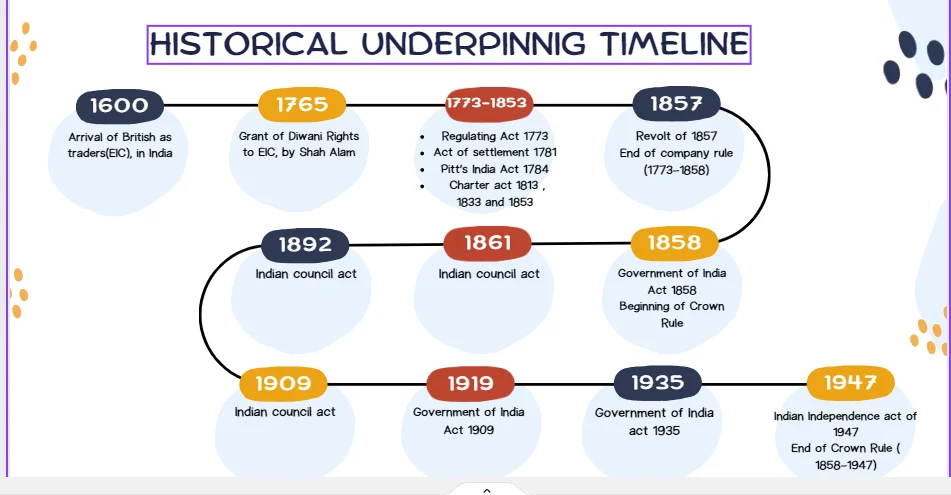The series of Charter Acts from 1793 to 1853 were pivotal in shaping British rule in India. These acts gradually centralized power, reformed the administration, opened up trade, and introduced significant legal and social changes, marking the evolution of British governance in India.

Charter Act of 1793 (Governor-General: John Shore)
Background: This act was passed against the backdrop of several significant developments in India, including

- The growing political and economic dominance of the East India Company in India.
- There were increasing tensions between the British and Indian rulers.
- The financial difficulties faced by the East India Company.
Enroll now for UPSC Online Course
This act had the following features
- Extension of Trade Monopoly: It extended the Company’s Charter to trade with India (its trade monopoly) for the next 20 years.
- Expansion of Governor-General’s Powers: It extended the overriding powers given to the Governor-General over his council under the Act of 1786 to all the future Governors-General.
- Exclusion of Commander-in-Chief: The Commander-in-chief was not to be a member of the council unless he was so appointed.
- Funding of the Board of Control: Members of the Board of Control and their staff were to be paid out of the Indian revenues, which continued up to 1919.
- Royal Approval for Appointments: Royal approval was mandated for the appointment of the Governor-General, the Governors, and the Commander-in-Chief.
- Restrictions on Senior Officials: The company’s senior officials could not leave the country without permission; doing so was treated as a resignation.
- Issuance of Trade Licenses: The Company was empowered to give licenses (known as ‘privilege’ or ‘country trade’) to individuals and the Company’s employees. These licenses paved the way for opium shipments to China.
- Annual Payment to British Government: The Company was to pay 5 lakh pounds annually to the British government from the Indian revenues after paying the necessary expenses.
- Separation of Revenue and Judicial Functions: The revenue administration and judiciary functions were separated, and subsequently, Maal Adalats (revenue courts) disappeared.
Significance
- Centralization of Power: The act centralized power under the Governor-General of Bengal, granting him greater authority over the presidencies of Madras and Bombay.
- This centralization aimed to improve coordination and efficiency in the administration of British India.
- Reorganization of Judiciary: The act reorganized the judiciary, separating revenue administration from judicial functions.
- This separation aimed to improve the impartiality and effectiveness of the judicial system.
- Regulation of Trade: The act regulated the East India Company’s trade, restricting its monopoly on salt and opium.
- This regulation aimed to address concerns about the Company’s exploitative practices and protect Indian interests.
Charter Act of 1813 ( Governor-General: Hastings)
Background: Business interests in England were pressing to end the Company’s monopoly over Indian trade due to:

- Emerging spirit of laissez-faire.
- Napoleon enforced the closing of the European ports for Britain under the continental system.
Some key features of the Charter Act of 1813 are
- End of the East India Company’s Monopoly: The act abolished the East India Company’s monopoly on trade with India, except for trade in tea and opium with China.
- This opened up trade opportunities for British merchants and other European traders, promoting economic competition and diversification in India.
- Promotion of Education and Knowledge: The act allocated 1 lakh rupees annually for the promotion of education and knowledge in India.
- This funding aimed to establish schools, colleges, and libraries, fostering intellectual growth and development in the country.
- Religious Freedom and Missionary Activities: The act granted Christian missionaries the right to propagate their faith in India.
- This provision, while controversial, reflected a growing interest in religious conversion and cultural influence in British India.
- Strengthening of Judiciary: The act empowered the Supreme Court of Calcutta to extend its jurisdiction over all British subjects, including those residing in the interior of India.
- This strengthened the judicial system and provided greater access to justice for British subjects.
- Explicit Recognition of British territories in India: The Company was to retain the possession of territories and the revenue for 20 years more without prejudice to the sovereignty of the Crown.
- The regulations made by the Councils of Madras, Bombay, and Calcutta were now required to be laid before the British Parliament.
- The constitutional position of the British territories in India was thus explicitly defined for the first time.
| Significance | Limitation |
|
|
Charter Act of 1833 (Governor-General of India: William Bentick)
Background: British and other European trading companies were lobbying to completely remove the monopoly granted to the East India Company. The Company also had much more territory under its control. Hence to regulate its power, Charter Act 1833 was enacted.

Some of the key features are
-
- Extension of the Company’s Lease: The lease of 20 years to the Company was further extended. Territories of India were to be governed in the name of the Crown.
- End of Trade Monopoly: The Company’s monopoly over trade with China and in tea also ended.
- Lifting of Immigration and Property Restrictions: All restrictions on European immigration and the acquisition of property in India were lifted. Thus, the way was paved for the wholesale European colonization of India.
- Centralization of Government Power: In India, a financial, legislative, and administrative centralization of the government was envisaged:
-
- Expanded Authority of the Governor-General: The Governor-General was given the power to superintend, control, and direct all civil and military affairs of the Company.
- Control Over Territories: Bengal, Madras, Bombay, and all other territories were placed under complete control of the Governor-General.
- Revenue Control by Governor-General: All revenues were to be raised under the authority of the Governor-General, who would have complete control over the expenditures, too.
- Reduction of Legislative Powers for Madras and Bombay: The Governments of Madras and Bombay were drastically deprived of their legislative powers and left with a right to propose to the Governor-General the projects of law which they thought to be expedient.
- Addition of a Law Member: A law member was added to the Governor-General’s council for professional advice on law-making.
- Codification of Indian Laws: Indian laws were to be codified and consolidated.
- Prohibition of Discrimination in Employment: No Indian citizen was to be denied employment under the Company on the basis of religion, colour, birth, descent, etc. (Although the reality was different, this declaration formed the sheet anchor of political agitation in India.)
- Steps Toward Abolition of Slavery: The administration was urged to take steps to ameliorate the conditions of slaves and to ultimately abolish slavery. (Slavery was abolished in 1843.)
Significance
- Establishment of the Indian Law Commission: The act established the Indian Law Commission, tasked with codifying and reforming Indian laws.
- This aimed to create a more comprehensive, consistent, and fair legal system in India.
- Admission of Indians into Civil Service: The act opened up the East India Company’s civil service to Indians based on merit and qualifications.
- This aimed to improve the representation and participation of Indians in the administration of British India.
Charter Act of 1853 (Governor-General of India: Dalhousie)
Background: The Charter Act of 1853 was the final renewal of the East India Company’s charter, granted under the British monarchy. It was passed by the British Parliament in response to the growing concerns about the Company’s administration of India and the need for further reforms. The act aimed to address the shortcomings of previous legislation and introduce new measures to improve the governance and administration of British India.

Some of the key features are
- Continuation of Company’s Territorial Possession: The Company was to continue possession of territories unless the Parliament provided otherwise.
- Reduction in Court of Directors: The strength of the Court of Directors was reduced to 18.
- Abolition of Patronage System: The Company’s patronage over the services was dissolved—the services were now thrown open to a competitive examination.
- Law Member as Full Council Member: The law member became the full member of the Governor-General’s executive council.
- Separation of Executive and Legislative Functions: The separation of the executive and legislative functions of the Government of British India progressed with the inclusion of six additional members for legislative purposes.
- Introduction of Local Representation: Local representation was introduced in the Indian legislature. The legislative wing came to be known as the Indian Legislative Council.
- Four of the six new legislative members of the Governor-General’s council were appointed by the local (provincial) governments of Madras, Bombay, Bengal, and Agra.
- However, a law to be promulgated needed the assent of the Governor-General, and the Governor-General could veto any bill of the legislative council.
Significance
- Modernization of Governance: The separation of legislative and executive powers and the introduction of competitive examinations for civil service recruitment were significant steps toward modernization and efficiency in governance.
Enroll now for UPSC Online Course
- Increased Indian Representation: The act’s emphasis on the representation and participation of Indians in the Legislative Council reflected a growing awareness of Indian aspirations and the need for greater involvement in their own governance.
| Must Read | |
| Current Affairs | Editorial Analysis |
| Upsc Notes | Upsc Blogs |
| NCERT Notes | Free Main Answer Writing |
Conclusion
These Charter Acts not only strengthened British control over India but also laid the groundwork for modern administrative practices and legal reforms. They reflected the shifting dynamics of British-Indian relations and the gradual opening of opportunities for Indian participation in governance.
Sign up for the PWOnlyIAS Online Course by Physics Wallah and start your journey to IAS success today!
| Related Articles | |
| THE ENGLISH IN INDIA | Charter Act |
| The East India Company’s Rise in India | Union Territories |

 GS Foundation
GS Foundation Optional Course
Optional Course Combo Courses
Combo Courses Degree Program
Degree Program











